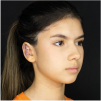Ear harmonization care and recovery with Dr. Jean Paul Salazar: a complete guide to a successful recovery.
Ear harmonization is a minimally invasive cosmetic procedure that has gained popularity in recent years. Due to its ability to correct imperfections in the shape and size of the ears without the need for deep incisions, it has become an attractive option for those seeking a subtle yet significant change in their appearance. If you have undergone this technique, it is crucial to follow specific care instructions during recovery to ensure optimal results and a swift, comfortable healing process. In this blog, we provide a comprehensive care guide and additional recommendations to ensure a successful recovery, reflecting the high quality of the technique applied by Dr. Salazar.
What is ear harmonization?
Ear harmonization is a minimally invasive technique involving the insertion of non-absorbable, biocompatible threads. These threads are used to reposition the ears, correcting issues such as inadequate formation of the antihelix or overly pronounced tips. Unlike traditional surgical procedures, which require deep incisions and longer recovery times, ear harmonization offers a faster, less invasive option with a much simpler recovery process.
Dr. Jean Paul Salazar has been a pioneer in Colombia in applying this technique, establishing himself as a reference in ear harmonization in the country. His precise approach and use of high-quality materials guarantee natural and long-lasting aesthetic results.
Important care:
Although ear harmonization is a relatively simple procedure, proper recovery requires specific care to ensure the healing process proceeds smoothly. Below, we share the most important recommendations to follow after the intervention, according to Dr. Jean Paul Salazar:
1. Medication for pain and inflammation:
It is normal to experience some pain and swelling in the treated area after the procedure. Your doctor will prescribe specific medications to manage these discomforts. Ensure you follow the prescribed frequency and dosage to avoid complications. Do not discontinue the medications until completing the prescribed course, even if you feel relief earlier.
2. Cleaning the treated area:
Keeping the area clean is essential to prevent infections and ensure proper healing. You should clean both the front and back of the ears with products recommended by your doctor. Clean them gently to avoid causing irritation.
3. Use of the compression band:
After ear harmonization, your doctor will likely recommend using a compression band, especially during the first few weeks. The band helps keep the ears in their correct position, preventing them from shifting or becoming misaligned. It is important to wear it daily for at least the first month, particularly while sleeping, and if possible, incorporate it into your daily routine.
4. Avoid high-impact activities.
During the initial weeks of recovery, it is essential to avoid high-impact sports like running, swimming, or activities involving physical contact. This precaution helps prevent pressure or trauma to the ear area, ensuring the threads heal properly.
5. Precautions when touching the ears:
It is important to be careful when touching or manipulating the ears. Avoid pulling on the ears abruptly or forcibly, as the threads could move or come loose, which would affect the final result of the procedure. In addition, the area may be somewhat sensitive during the first few days, so it is important to be gentle when touching it.
What to expect during recovery?
Experiencing some symptoms during recovery is completely normal. Common side effects include swelling and bruising around the ear area, which usually fade gradually over the following days. Following your doctor’s instructions carefully will help ensure a smoother recovery.
Swelling and Bruising: Swelling is a natural response of the body to any procedure. In the case of ear harmonization, it may cause the ears to appear slightly swollen or discolored (purple) during the first few days. This is temporary and will subside over time. Keeping the area clean is essential to promote healing.
Gradual Results: While you might notice an aesthetic improvement soon after the procedure, the final results will become more evident after several weeks. The threads heal gradually, and the ear’s shape will continue to improve throughout the first few weeks of recovery.
When to return to daily activities?
One of the benefits of ear harmonization is its quick recovery process. Most patients can resume their daily activities immediately after the procedure. However, it is strongly recommended to avoid activities that apply pressure or involve direct contact with the ears.
If you have questions about specific activities, consult Dr. Jean Paul Salazar for personalized guidance on what you can safely do during your recovery.
Additional considerations:
Avoid sun exposure: During the recovery phase, avoid direct sun exposure to the ear area, as the skin may be more sensitive and prone to burns. Protecting the area will help ensure proper healing.
Follow-up consultations: Dr. Salazar’s medical team will closely monitor your progress throughout the recovery process to ensure everything is proceeding as expected. If you have any questions or experience unusual symptoms, do not hesitate to contact them.
Ear harmonization, performed by Dr. Jean Paul Salazar’s expert medical team, is a procedure designed to improve the shape and harmony of the ears using an advanced, minimally invasive technique with fast recovery. By following the recommended post-procedure care, you can achieve the desired aesthetic results without complications.
The experience and knowledge of Dr. Salazar’s team guarantee a safe, effective, and personalized approach, providing you with confidence and peace of mind throughout the process.
If you are interested in ear harmonization or have questions about the recovery process, feel free to contact us. We are here to help you achieve the results you have always wanted.







